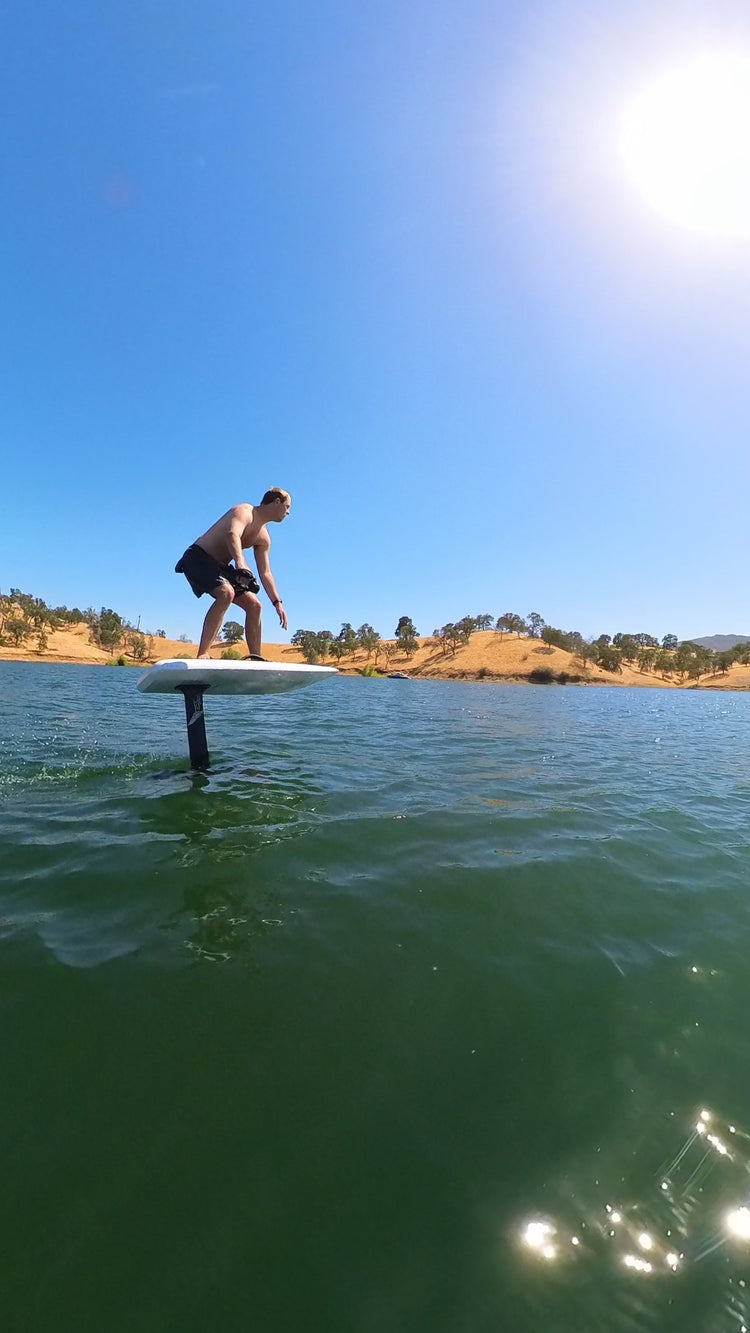
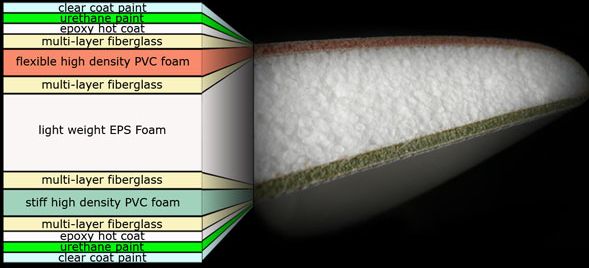
With Stand Up Paddleboarding growing so fast there are new paddleboard manufacturers entering the market all the time. Let's find out a bit about what makes a high quality stand up paddleboard.
Many stand up paddleboards look nearly identical when you view them from the outside, however it's largely what's inside that counts. While design is a huge component of performance we are going to focus on what you can't see. The inside. Much like cooking a meal the chef and the kitchen can be just as important as the recipe. In our experience we have found that two big pieces of the puzzle are the factory and the heritage of the chef.
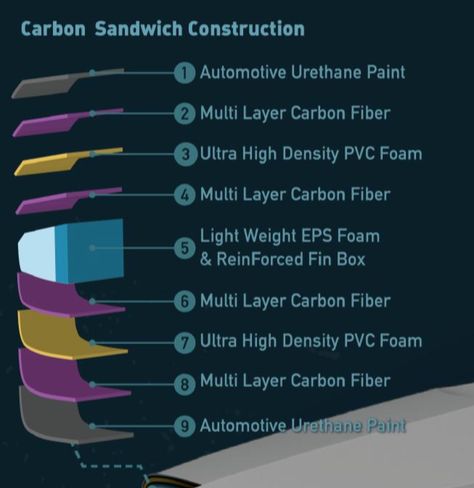
As for the factory we have found that the two best factories in the world stand head and shoulders above the rest. They are Kinetic in Vietnam and Cobra in Thailand. One of the reasons these two factories shine is they have a heritage in windsurfing manufacturing. The windsurfing industry pioneered these new construction techniques to meet the more stringent design requirements of a product engineered to launch a 200 lb. person 20 feet in to the air and then land again in one piece. Since most traditional prone surfboards are still made with stringers executing these new constructions is a step up the learning curve for most surf companies. However for an existing windsurfing manufacturer a paddleboard is in fact an easier product to manufacture. This gives heritage windsurfing companies like Starboard, Surftech, Naish, and Jimmy Lewis a big advantage when compared to a mainline surf company like Channel Islands.
First let's take a look at some terminology that is important to understand as we dissect the innards of the SUP Board.
EPS Foam Blank - This is what determines the shape of the board. Long story short make sure your foam is EPS. Polyester boards can not use EPS.
Stringer - most often a piece of wood that runs lengthwise and provides stiffness. Usually found in wet lay up polyester boards. Some companies are doing fancy things with stringers. For example carbon fiber stringers. Others may lay a layers of unidirectional cloth as a simulated stringer.
Epoxy and Polyester Resins - This is the liquid that hardens when poured over the fiberglass cloth. Without getting in to all details we prefer Epoxy over Polyester.
Wet Lay Up - This is the old school method for making boards. Very simply it's taking fiberglass cloth and pouring resin over the top and hand squeezing out the excess resin. Due to the poor structure and light layup of this process the board usually has a stringer.
Vacuum Bagging - Wet layup boards are by definition not vacuum bagged. Keeping things simple here vacuuming is very important for not only reducing weight but also durability and strength. Getting the fiberglass cloth saturated with just the right amount of resin is a huge part of the secret sauce.
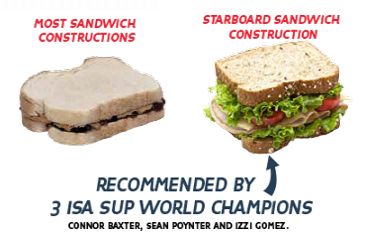 Sandwich Construction - Now we are getting in to the good stuff. Sandwich construction is by definition at least three layers. Not all sandwiches are created equal. Check out the Starboard advertisement at right. The thicker the sandwich the better the board. However making a thick sandwich can result in a heavy board. This is where the recipe, the chef, and the kitchen are so critical in getting a light strong board. There are usually no stringers in sandwich construction boards.
Sandwich Construction - Now we are getting in to the good stuff. Sandwich construction is by definition at least three layers. Not all sandwiches are created equal. Check out the Starboard advertisement at right. The thicker the sandwich the better the board. However making a thick sandwich can result in a heavy board. This is where the recipe, the chef, and the kitchen are so critical in getting a light strong board. There are usually no stringers in sandwich construction boards.
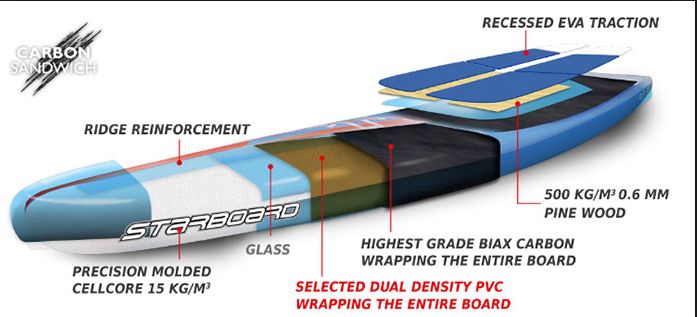
Carbon Fiber - When replacing the fiberglass cloth with carbon fiber cloth you will be approaching the ultimate in construction. It’s also the most expensive. Some manufacturers may blend carbon with regular fiberglass and sometimes even wood. Carbon is by far the strongest of all the materials. To be specific we are talking tensile strength. This is a measure of how hard it is to pull something apart - to break it. This does not always translate to durability. Carbon Fiber is quite stiff and there for may ding a little easier than say a wood board. The woods softer properties can make it slightly more durable than carbon. When it comes to performance however carbon is hands down the best. While the weight reduction does greatly increase performance it’s the flex control that drives a new paradigm in performance. Carbon Fiber also has super high fatigue levels. Repeated flexing will not wear out as fast as fiberglass. You've experience poor fatigue properties if you have ever tried to fold a credit card.
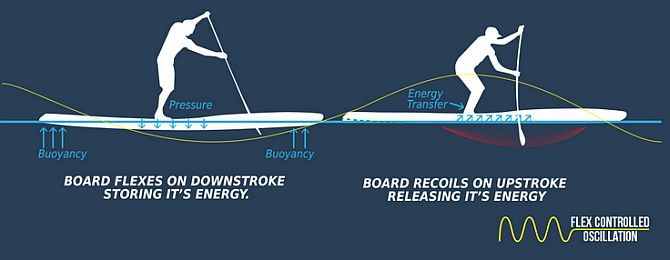
Flex is super important when talking about performance and it’s a bit of a goldilocks syndrome. Not too stiff. Not too soft. We want it just right. Precision manufacturing can orient the carbon into patterns that can precisely control the flex. Lay the fibers at 45 degree angles (known as biaxial) and you get the ultimate in stiffness. Fibers can then be reoriented in different patterns to give the desired flex feel.
The back side of flexing something is when it recoils to its original state (see graphic above). To get fancy on you it's called "the coefficient of restitution." And this is where carbon is unmatched. For example if you were to flex a piece of fiberglass and then time how long it took to spring back to its original shape and then do the same thing with the carbon fiber. You'll find the carbon fiber will recoil 4 times faster than standard fiber glass.
As with most things every decision has a tradeoff. In the world of stand up paddleboard manufacturing here are the key variables.
1. Cost
2. Weight
3. Stiffness
4. Strength (break in half)
5. Durability (dings and dents)
Let’s start at the bottom and talk in generalities about each construction.
- Wet Lay Up - Least Expensive. Heaviest. Stiffness is determined largely by stringer but the boards are usually not stiff or have poor flex. Strength is low while durability is actually Ok. Soft things are more durable in general.
- Vacuum Bagged - More Expensive. Lighter. Better stiffness. Stronger and more durable. Nothing bad to say about vacuum bagging other than the price of the product needs to go up to account for the time and effort in production.
- Sandwich Construction - Next most expensive. Lighter. Better stiffness control. Stronger and more durable. We love sandwiches.
- Sandwich Construction with wood - Next most expensive and one of our favorite constructions. Great durability, Flex, and performance. Better stiffness control. Better durability and for some a better feel. Think mountain bike with shocks. One key question to as is "How much wood and where is it?” Some manufacturers may only place one patch in the standing area. Some manufacturers may only do one layer on the top of the board. A high quality wood board will have a full sheet and top and bottom. To our knowledge no one is doing the rails of the boards in wood but if you find one it’s a nice enhancement.
- Sandwich Construction Carbon with PVC/Fiberglass - This represents the ultimate performance recipe available on the market today. It's the lightest, flex controlled, durable construction you can buy. You can also get PVC Sandwich boards with Fiberglass as well. These boards will be slightly heavier, recoil a bit slower, and be a bit less expensive. A Fiberglass PVC Sandwich board will not be as strong as a Carbon PVC Sandwich board but they may be a bit more durable to point loading impacts.
Armed with all this information you then need to look at the boards and start asking questions. Each manufacturer will assemble these components in their own way. Some may use only a small piece of wood in the standing area where others are using full sheets - top and bottom. Some manufacturers will use PVC sandwich in only one area of the board and to our knowledge only two are doing complete boards in PVC sandwich.
And so to answer the question directly offered up by the title of this article the answer is every single board made by Jimmy Lewis and the Starboard boards made in Carbon. These two brands represent the pinnacle of board building today.
Boards Manufactured at Cobra (Thailand) - Starboard, NSP, Naish, Surftech, SIC Maui, Fanatic, Amundson
Boards Manufactured at Kinetic (Vietnam) - Jimmy Lewis, 404 (new this year), and we have heard word that Laird is moving his operations to Kinetic as well.
With all this said we do have to pay homage to 3 pioneers in the field. Starboard really has pushed the envelope in construction for over 25 years and is one of the pioneers of wood boards. Jimmy Lewis has been at the forefront of composite design for even longer, while Surftech through their licensing program brought composite construction to the masses.
For more information please do feel free to stop by the shop and take a look at our cross section bin. We take all the major manufacturers and cut their boards up so you can see the guts first hand.
And before we leave you we didn't even cover one of the biggest construction variables. That is how the finbox and an other inserts are handled. We will let Jimmy Lewis explain that one. Just watch the video below.

